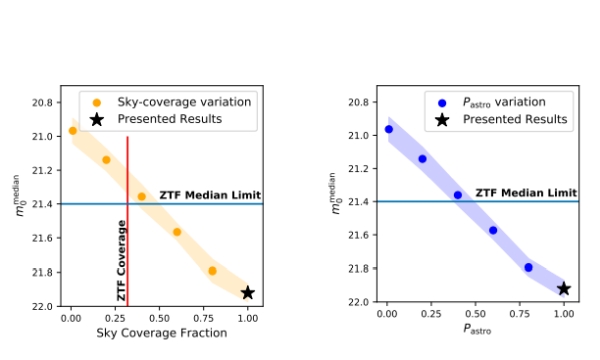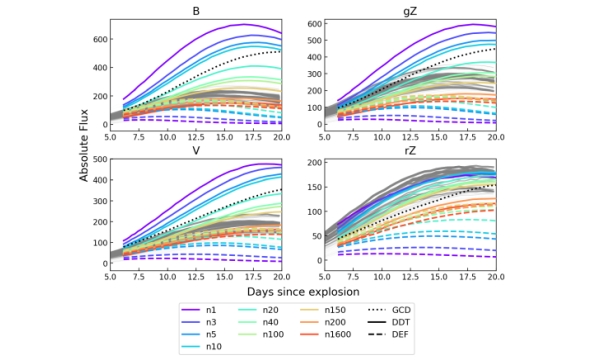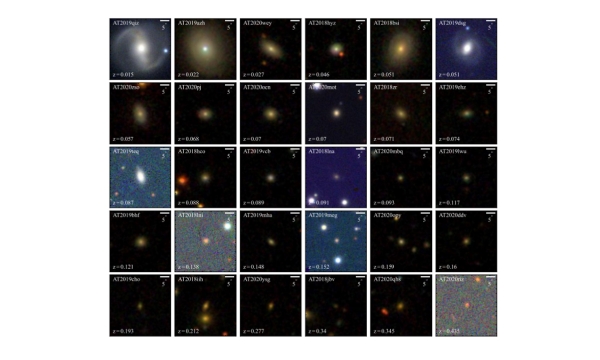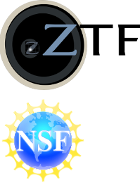ZTF Public Data Release 10
The Zwicky Transient Facility (ZTF) and IPAC at the California Institute of Technology announce the tenth ZTF Public Data Release. This release adds 2 months of observations to the ninth data release, up to 5 Jan 2022 for the public portion of the survey, and private survey time prior to 4 Sept 2020. The products include ~36 million single-exposure images, ~163,000 co-added images, accompanying source catalog files containing ~600 billion source detections extracted from those images, and over 4 billion light curves constructed from the single-exposure extractions. Access to the data products is available via the on-line and API services of the NASA/IPAC Infrared Science Archive (IRSA).
Science Highlights
A Bayesian framework to infer kilonova populations
In a recent publication, astronomers from the ZTF partnership present nimbus: a hierarchical Bayesian framework to infer the intrinsic luminosity parameters of kilonovae (KNe) associated with gravitational-wave (GW) events, based purely on nondetections. This framework makes use of GW 3D distance information and electromagnetic upper limits from multiple surveys for multiple events and self-consistently accounts for the finite sky coverage and probability of astrophysical origin.
Constraining Type Ia supernovae with ZTF
Time-domain surveys such as the ZTF enable astronomers to catch Type Ia supernovae sooner and sooner after explosion, which has exposed significant variation in their early light curves. In this study, ZTF astronomers perform an analysis of the largest young SN Ia sample to date. They compare 115 SN Ia light curves from the Zwicky Transient Facility to the turtls model grid containing light curves of Chandrasekhar-mass explosions with a range of nickel masses, nickel distributions and explosion energies.
Tidal Disruption Events in the ZTF Phase I
Led by ZTF partners at the University of Maryland, a team of astronomers present a uniformly selected sample of 30 spectroscopically classified TDEs from the Zwicky Transient Facility Phase I survey operations with follow-up Swift UV and X-ray observations. Correlations between light curve properties reveal a shallow positive correlation between the peak bolometric luminosity and decay timescales. The authors also introduce a new spectroscopic class of TDE.
ZTF Faces
The Zwicky Transient Facility is designed to push the frontiers of exploration of the dymanic cosmos. Weather permitting, it's been continuously scanning the northern sky every two nights since 17th March 2018 building an impressive time-domain survey. This is all possible because a dedicated team of engineers at the Caltech Optical Observatories have in turn pushed the frontiers of engineering by designing and building a wide field camera and a robotic system that together comprise a uniquely efficient observing system. In this issue of Cosmic Newsflash, we turn the spotlight on members of our engineering team who keep ZTF up and running. These colleagues have worked particularly hard in the last two months to address issues with the ZTF cryocoolers and subsequent zeolite contamination that reached the ZTF camera. On behalf of the ZTF partnership, we thank them all for always being ready to "go the extra mile".
Read moreZTF Science Vlog
The ZTF vlog brings you the latest ZTF results presented by the authors themselves.
ZTF captures the largest sample of the brightest supernovae
Chen, Z.H. et al., and Chen, Z.H. et al.,
We have been observing superluminous supernovae for a while now, but for the first time, ZTF has captured a large enough sample for astronomers to begin to probe their explosion mechanisms. Listen to Zhihao Chen who describes the first dataset and analysis results in this ZTF science vlog.
Supernova siblings in the ZTF survey
In this science vlog, Melissa Graham (UW, Seattle) describes the small but growing sample of supernova siblings discovered with ZTF. Previously thought to be of the same type, siblings in this sample exhibit differences in their type.
Science with public ZTF data
We highlight scientific publications from individuals and groups outside of the ZTF partnership that use ZTF public data
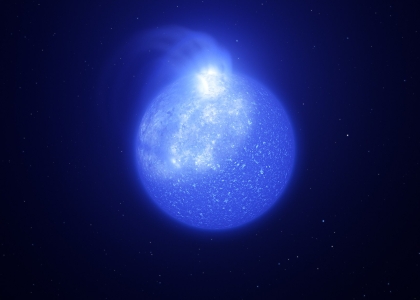
Artist's impression of a sdB star, showing a giant hot spot. Credit: ESO/L. Calçada, INAF-Padua/S. Zaggia
Finding Blue Large Amplitude Pulsators from Gaia DR2 & ZTF DR3
Paul Ross McWhirter and Lam, Marco C.
In this paper, we identify 22 candidate Blue Large Amplitude Pulsators (BLAPs), rare hot subluminous pre-white dwarfs resulting from the evolution of a specific configuration of interacting binary systems. We utilised astrometric data from Gaia DR2 and 3D dust maps from the first Pan-STARRS 1 data release to identify intrinsically faint blue stars that can be seen in the northern hemisphere with large variability in their brightness. Detected sources with similar photometric properties to the known BLAP population are closely analysed using photometric data from ZTF's third public data release. We combined the signal of their periodic changes in brightness and a mathematical (conditional entropy) algorithm to detect the variability. Nine of the candidates exhibit brightness variations very similar to the previous BLAP population with periods of under one hour. Spectroscopic follow-up observations of these candidates reveal they are blue sources with similar spectroscopic features to the existing BLAP population. Higher-resolution spectra of one specific candidate show that the effective temperature, surface gravity and helium abundance are in agreement with the confirmed BLAPs.
--Paul Ross McWhirter
Instituto de Astrofísica de Canarias, Tenerife, Spain
'How-to' Guide
Bulk download of all lightcurves
Each public data release allows users to bulk download all lightcurves in Apache Parquet format. A selection of basic (most necessary) metadata accompany each lightcurve, primarily IDs to enable the retrieval of associated metadata from the archive, for example, images or Object Table metrics. You can find all information about bulk downloads in section 12c of each DR guide.
DR 10 GuideZTF is supported by the National Science Foundation and a collaboration including Caltech, IPAC, the
Weizmann Institute for Science, the Oskar Klein Center at Stockholm University, the University of
Maryland, Deutsches Elektronen-Synchrotron and Humboldt University, Lawrence Livermore National
Laboratory, the TANGO Consortium of Taiwan, the University of Wisconsin at Milwaukee, Trinity College
Dublin, IN2P3, University of Warwick, Ruhr University Bochum, and Northwestern University . Operations are conducted
by COO, IPAC and University of Washington.
Any opinions, findings, and conclusions or recommendations expressed in this material are those of the
author(s) and do not necessarily reflect the views of the National Science Foundation.
